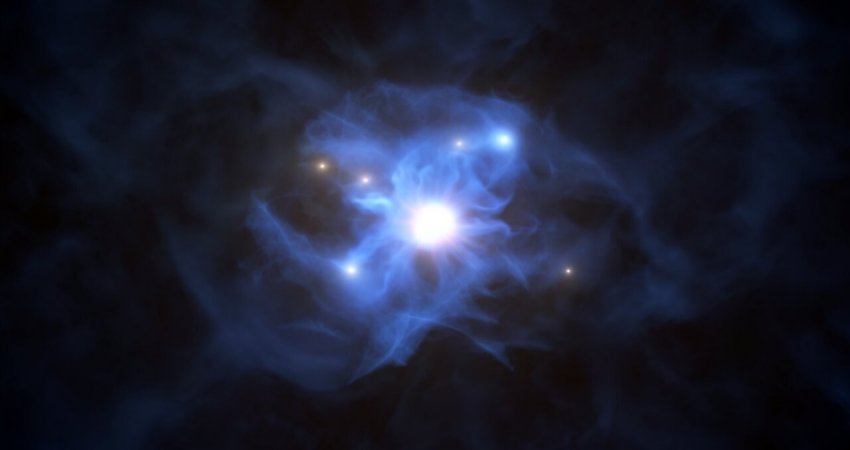Eddie Gonzales Jr. – MessageToEagle.com – Using ESO’s Very Large Telescope (VLT), astronomers have found six galaxies lying around a supermassive black hole when the Universe was less than a billion years old.

“This research was mainly driven by the desire to understand some of the most challenging astronomical objects — supermassive black holes in the early Universe. These are extreme systems and to date, we have had no good explanation for their existence,” Marco Mignoli, an astronomer at the National Institute for Astrophysics (INAF) in Bologna, Italy, and lead author of the new research, said in a press release.
The galaxies surrounding a supermassive black hole, all lying in a cosmic “spider’s web” of gas extending to over 300 times the size of the Milky Way.
“The cosmic web filaments are like spider’s web threads,” explains Mignoli.
“The galaxies stand and grow where the filaments cross, and streams of gas — available to fuel both the galaxies and the central supermassive black hole — can flow along the filaments.”
The light from this large web-like structure, with its black hole of one billion solar masses, has traveled to us from a time when the Universe was only 0.9 billion years old.
“Our work has placed an important piece in the largely incomplete puzzle that is the formation and growth of such extreme, yet relatively abundant, objects so quickly after the Big Bang,” says co-author Roberto Gilli, also an astronomer at INAF in Bologna, referring to supermassive black holes.
The very first black holes, thought to have formed from the collapse of the first stars, must have grown very fast to reach masses of a billion suns within the first 0.9 billion years of the Universe’s life.

But how did such large web-like structures form in the first place?
Astronomers think giant halos of mysterious dark matter are key. These large regions of invisible matter are thought to attract huge amounts of gas in the early Universe; together, the gas and the invisible dark matter form the web-like structures where galaxies and black holes can evolve.
“Our finding lends support to the idea that the most distant and massive black holes form and grow within massive dark matter halos in large-scale structures, and that the absence of earlier detections of such structures was likely due to observational limitations,” says Colin Norman of Johns Hopkins University in Baltimore, US, also a co-author on the study.
The galaxies now detected are some of the faintest that current telescopes can observe. Using the MUSE and FORS2 instruments on the VLT at ESO’s Paranal Observatory in the Chilean Atacama Desert, the team confirmed the link between four of the six galaxies and the black hole.
“We believe we have just seen the tip of the iceberg, and that the few galaxies discovered so far around this supermassive black hole are only the brightest ones,” said co-author Barbara Balmaverde, an astronomer at INAF in Torino, Italy.
Written by Eddie Gonzales Jr. – MessageToEagle.com Staff






